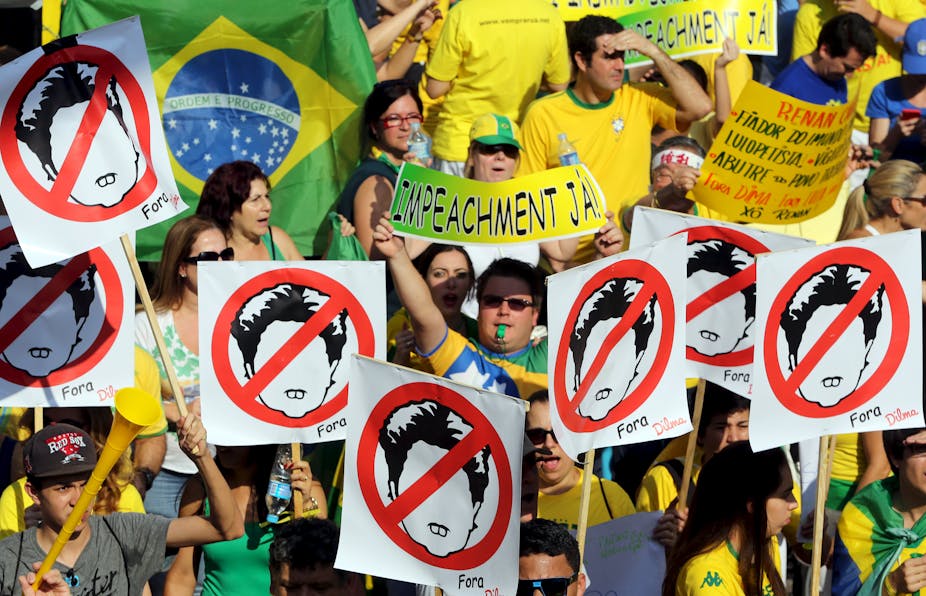Hundreds of thousands of Brazilians took to the streets on August 16 to speak out against their government. On São Paulo’s Avenida Paulista, protesters dressed in the yellow and green colours of the Brazilian flag carrying banners that called for president Dilma Rousseff to be removed from office.
The numbers were lower than the protest organisers had hoped (and the government feared), but nevertheless they point to a crisis unfolding in Brazil. Rousseff finds herself on increasingly shaky political ground while the country’s economic turmoil deepens and accusations of corruption intensify.
But while the protesters are unified by their rejection of the current government, they remain divided over their long-term objectives. Some want Rousseff to resign while others won’t be content until she is impeached for corruption. Then there is the question of what happens after she is gone – an issue causing no small amount of division.
Rousseff may well be able to capitalise on this lack of a shared vision to ride out the storm.
Origins of unrest
These latest protests are a resurgence of the dissent that began in 2013. Mass demonstrations erupted in June that year as the public called for government spending on health, education and transport. The unrest came as a surprise after years of economic growth and significant improvements in living standards.
Another three mass rallies have taken place in 2015, during which protesters called for Rousseff to be impeached. A vocal minority is even demanding military intervention to get her out of power.
The scandals go to the heart of Brazil’s recent economic success. Many Brazilians, both rich and poor, have benefited from economic growth and the public spending that has come about as a result, but some are turning against the government as the economy slows down.
The current protests have adopted a popular but unhealthy Brazilian snack called coxinha (essentially a chicken nugget) as their emblem. For the protesters, coxinha signifies the honest, hard-working everyman who pays taxes and wants nothing to do with corruption.
Meanwhile, adversaries see the protesters as small-minded conservatives with contradictory opinions. They criticise Venezuela as a socialist dictatorship while supporting military intervention in their own country. According to a survey conducted during the March 2015 demonstrations, the profile of this year’s protester is predominantly white, roughly 40 years old and with an above average income and level of education.
Dilma’s demise
Although her approval ratings have reached a record low of 8%, Rousseff rejects any suggestion that she will resign, while referring to the dangers of a growing coup culture and a climate of intolerance. Social movements have mobilised in support of democracy and the government – although they have also used the opportunity to try to push the governing Workers’ Party (PT) to the left, criticising its neo-liberal policies.
Corruption scandals, linked to oil company Petrobas, have troubled the PT since 2005, implicating key political figures close to the president. The opposition alleges that Rousseff may have been aware of the corruption when she was energy minister under former president Luiz Inácio “Lula” da Silva.
But there is plenty of political opportunism at work as Rousseff’s opponents decide whether she should be investigated.

The PT’s coalition partner, the Brazilian Democratic Movement Party (PMDB), could benefit from impeachment as the vice-president, Michel Temer, would become president. But with several of its key politicians accused of corruption too, the party cannot assume a straightforward handover of power either.
For its part, the main opposition party, the Brazilian Social Democratic Party (PSDB), openly supports the demonstrations. Its leader, Aécio Neves, even spoke at an anti-government protest in Belo Horizonte. He narrowly lost the 2014 elections to Rousseff and initially called for her to be impeached. He now appears to support a resignation instead, since impeachment would mean waiting until 2018 for a chance to stand in an election. The PSDB is a divided party, as presidential hopefuls position themselves for the 2018 elections – calculating that their chances will increase in parallel with a further weakening of the PT.
An opposition divided
During the demonstrations, the different protest groups used sound trucks to deliver their message to the protesters. Loud as the sound systems were, the speeches, music and slogans became blurred, an apt metaphor for their own ideological and strategic fragmentation.
Rogério Chequer of the “Come to the Streets” movement views Rousseff’s resignation as preferable but Marcello Reis of “Revoltados Online” prefers impeachment. Groups such as the Nationalist Democratic Union call for a military intervention. The protesters have also been selective in their allegations, accusing PT politicos and appointees of corruption but ignoring opposition transgressions.
The outcome of all this will partly depend on Rousseff’s ability to strike a deal with her coalition partners to avoid an impeachment vote in Congress. As opposition politicians supporting the protests are acutely aware, the protests put pressure on the government – which could be to their medium-term benefit, but Rousseff’s unpopularity does not necessarily justify impeachment.
In Brazil’s relatively young democracy, various actors are seeking to maximise their advantage and to limit potential damage. The confusion reminds us that a question mark remains over the status of the country’s political culture – and exactly who can lay claim to legitimacy when so many stand to gain from the fall of the current president.

